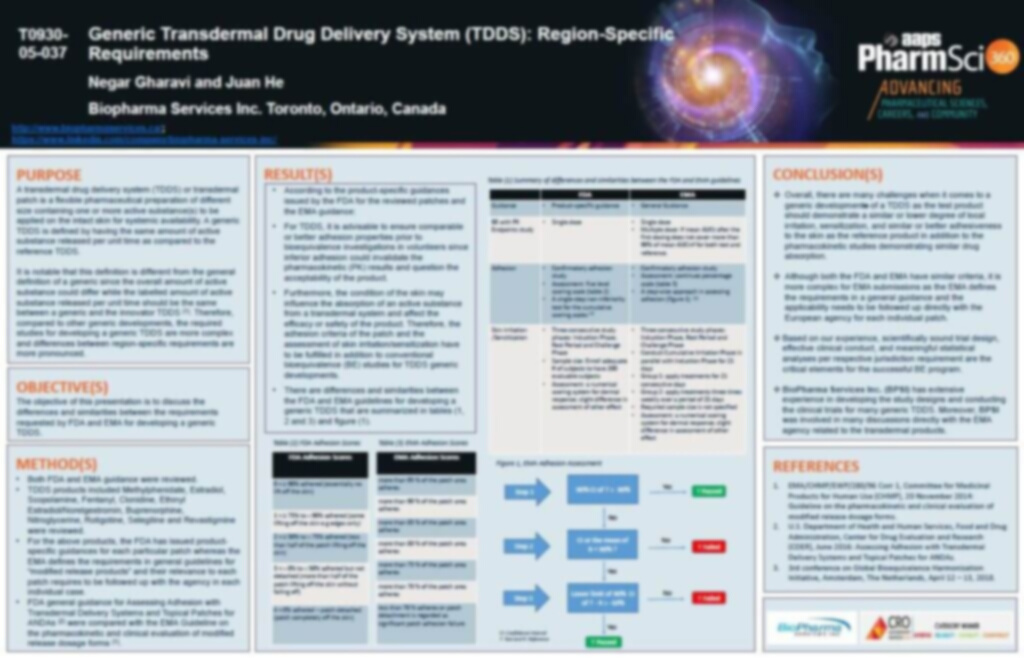GENERIC TRANSDERMAL DRUG DELIVERY SYSTEM (TDDS): REGION-SPECIFIC REQUIREMENTS
PRESENTED TO: AAPS PharmaSci 360 Annual Meeting 2018
PRESENTED BY: N. Gharavi, J. He.
PURPOSE
A transdermal drug delivery system (TDDS) or transdermal patch is a flexible pharmaceutical preparation of different size containing one or more active substance(s) to be applied on the intact skin for systemic availability. A generic TDDS is defined by having the same amount of active substance released per unit time as compared to the reference TDDS. It is notable that this definition is different from the general definition of a generic since the overall amount of active substance could differ while the labelled amount of active substance released per unit time should be the same between a generic and the innovator TDDS (1). Therefore, compared to other generic developments, the required studies for developing a generic TDDS are more complex and differences between region-specific requirements are more pronounced.

OBJECTIVE(S)
The objective of this presentation is to discuss the differences and similarities between the requirements requested by FDA and EMA for developing a generic TDDS.
METHOD(S)
- Both FDA and EMA guidance were reviewed
- TDDS products included Methylphenidate, Estradiol, Scopolamine, Fentanyl, Clonidine, Ethinyl Estradiol/Norelgestromin, Buprenorphine, Nitroglycerine, Rotigotine, Selegiline and Revastigmine were reviewed.
- For the above products, the FDA has issued product specific guidances for each particular patch whereas the EMA defines the requirements in general guidelines for “modified release products” and their relevance to each patch requires to be followed up with the agency in each individual case.
- FDA general guidance for Assessing Adhesion with Transdermal Delivery Systems and Topical Patches for ANDAs (2) were compared with the EMA Guideline on the pharmacokinetic and clinical evaluation of modified release dosage forms (1).
RESULT(S)
- According to the product-specific guidances issued by the FDA for the reviewed patches and the EMA guidance:
- For TDDS, it is advisable to ensure comparable or better adhesion properties prior to bioequivalence investigations in volunteers since inferior adhesion could invalidate the pharmacokinetic (PK) results and question the acceptability of the product.
- Furthermore, the condition of the skin may influence the absorption of an active substance from a transdermal system and affect the efficacy or safety of the product. Therefore, the adhesion criteria of the patch and the assessment of skin irritation/sensitization have to be fulfilled in addition to conventional bioequivalence (BE) studies for TDDS generic developments.
- There are differences and similarities between the FDA and EMA guidelines for developing a generic TDDS that are summarized in tables (1, 2 and 3) and figure (1).
Table (1) Summary of differences and similarities between the FDA and EMA guidelines
| FDA | EMA | |
| Guidance |
|
|
| BE with PK Endpoints study |
|
|
| Adhesion |
|
|
| Skin irritation / Sensitization |
|
|
Table (2) FDA Adhesion Scores
| FDA Adhesion Scores |
| 0 = ≥ 90% adhered (essentially no lift off the skin) |
| 1 = ≥ 75% to < 90% adhered (some lifting off the skin e.g edges only) |
| 2 = ≥ 50% to < 75% adhered (less than half of the patch lifting off the skin) |
| 3 = > 0% to < 50% adhered but not detached (more than half of the patch lifting off the skin without falling off) |
| 4 = 0% adhered – patch detached (patch completely off the skin) |
Table (3) EMA Adhesion Scores
| EMA Adhesion Scores |
| more than 95 % of the patch area adheres |
| more than 90 % of the patch area adheres |
| more than 85 % of the patch area adheres |
| more than 80 % of the patch area adheres |
| more than 75 % of the patch area adheres |
| more than 70 % of the patch area adheres |
| less than 70 % adheres or patch detachment is regarded as significant patch adhesion failure |
CONCLUSION(S)
- Overall, there are many challenges when it comes to a generic developments of a TDDS as the test product should demonstrate a similar or lower degree of local irritation, sensitization, and similar or better adhesiveness to the skin as the reference product in addition to the pharmacokinetic studies demonstrating similar drug absorption.
- Although both the FDA and EMA have similar criteria, it is more complex for EMA submissions as the EMA defines the requirements in a general guidance and the applicability needs to be followed up directly with the European agency for each individual patch.
- Based on our experience, scientifically sound trial design, effective clinical conduct, and meaningful statistical analyses per respective jurisdiction requirement are the critical elements for the successful BE program.
- BioPharma Services Inc. (BPSI) has extensive experience in developing the study designs and conducting the clinical trials for many generic TDDS. Moreover, BPSI was involved in many discussions directly with the EMA agency related to the transdermal products.
REFERENCES
- EMA/CHMP/EWP/280/96 Corr 1, Committee for Medicinal Products for Human Use (CHMP), 20 November 2014: Guideline on the pharmacokinetic and clinical evaluation of modified release dosage forms.
- U.S. Department of Health and Human Services, Food and Drug Administration, Center for Drug Evaluation and Research (CDER), June 2016: Assessing Adhesion with Transdermal Delivery Systems and Topical Patches for ANDAs.
- 3rd conference on Global Bioequivalence Harmonisation Initiative, Amsterdam, The Netherlands, April 12 – 13, 2018.



